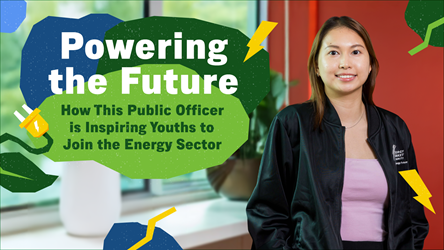Blue Skies and Beyond

Share with us what you do at work.
I’m a Senior Manager with the Airworthiness/Flight Operations Division at the Civil Aviation Authority of Singapore (CAAS).
My team is responsible for ensuring the safe operation of Unmanned Aerial Systems (UAS) in Singapore. This includes performing technical assessments of UAS as well as ensuring that their use by commercial operators and hobbyists doesn’t compromise public and aviation safety.
We also review and develop UAS-related policies, regulation and standards. One example is the enhanced regulatory and permit framework for drone operations in Singapore, which was rolled out in June 2015.
Describe what it was like before you tried something new at work, and what happened after. How do you feel about the outcome?
I was previously with the Continuing Airworthiness section at CAAS, for six years. There, I was part of the team that regulated air operators, aerospace maintenance organisations and general aviation operators, to ensure that Singapore-registered aircraft are maintained to the required airworthiness standards.
But when I moved over to the UAS section, I found it extremely challenging. Unlike the well-established regulatory framework for manned aircraft – set out by the International Civil Aviation Organization (ICAO) – we’re still in the infancy stage when it comes to developing a similar framework for UAS. There’s also no international guidance as yet, so we had to develop our own regulations from scratch.
It was hard for me to step out of my comfort zone and move on to work in an unknown area. But I have no regrets about my move, as I truly enjoy the challenge of our work. I feel privileged to be part of the team that introduced and implemented the enhanced regulatory and permit framework.
What challenges did you encounter in developing the framework?
UAS are an emerging and dynamic industry. In Singapore, drones are being developed and used for leisure as well as commercial and academic purposes. It’s imperative that CAAS is updated on the latest industry trends, in order to meet the changing needs of our stakeholders. We also have to keep an open mind and be ready to review policies when needed.
In formulating policies, the challenge is to strike a calibrated balance between promoting the growth of the UAS industry and ensuring the safety of the public in UAS operations. In our enhanced framework, we’ve adopted a risk-based approach that requires industry players to perform their own risk assessments of drone operations, and to develop mitigating actions to ensure that they fly drones safely. This allows the industry to internalise the safety culture, and to grow with a safety mindset.

How about hobbyists, photographers and other general users of drones?
Among the public, there’s a general perception that UAS are toys. Our challenge is in raising awareness of UAS’ impact on safety, especially when they’re operated in an urban landscape. That’s why we’ve run several public awareness campaigns to educate the public on the do’s and don’ts of flying drones.
What inspires you to do this work?
My kids love drones and I hope that they will be able to enjoy flying them without causing any danger to themselves or the public. My current portfolio allows me to play a direct role in shaping the UAS landscape. It was extremely encouraging when my kids came back from school one day with a CAAS flyer on flying drones. It was a golden opportunity for me to educate them on drone safety!
How did your supervisor and colleagues support you in developing the framework?
My division and section heads were extremely supportive, and were always around to provide guidance.
Many public agencies also helped to make the enhanced framework a reality. In the framework, CAAS serves as a “one-stop shop” for processing all drone permit applications, to make it easier for members of the public to fly drones. CAAS has to coordinate applications with other public agencies, and this wouldn’t be possible without the assistance of fellow public officers.
Complete the following sentence: I serve in the Public Service because…
I’m keen to contribute to Singapore! The aviation industry has a significant impact of the growth of Singapore’s economy; it also supports other crucial sectors such as tourism. So I know I play a small part in building Singapore.
Why do you love your job?
There’s never a boring day. I’m always being challenged and given opportunities to grow. More importantly, my supportive supervisor and wonderful UAS team-mates make me look forward to work every day.
- POSTED ON
May 2, 2017









